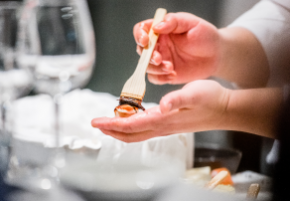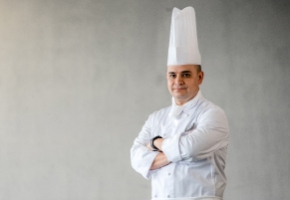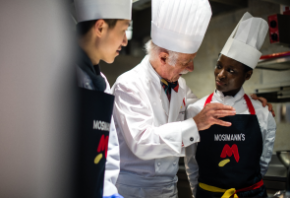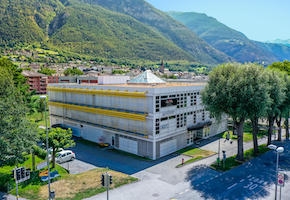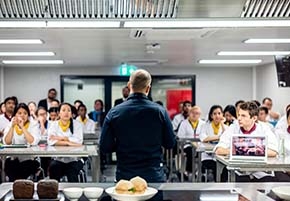- About
- Programs
- Campus Life
- Career Services
- Admissions
- News & Events
- Alumni
Food Cost Control: Strategies to Maximize Profits
Learn what effective food cost control is and improve your restaurant’s profitability with key strategies such as inventory tracking, portion control and more.
Key Takeaways
- Regularly tracking food costs helps spot problems early, prevent overspending, and stay ahead of price fluctuations.
- Implementing portion control, inventory optimization, and supplier negotiations helps reduce waste and improve cost efficiency.
- Digital tools and software can help restaurants track spending, manage inventory, and make smarter purchasing decisions.
Food cost control is the process of tracking, managing, and optimizing how much a restaurant spends on ingredients. It is not just about cutting expenses but making smarter choices that make every cent count without sacrificing quality.
Rising costs, over-ordering, spoilage, and portion control issues can quietly eat away at profits without anyone noticing until it is too late. But with the right strategies, it is possible to keep costs under control while still delivering dishes your guests will love. From mindful purchasing to better inventory habits, food cost control becomes the foundation for a more profitable, efficient, and stress-free operation.
At the Culinary Arts Academy Switzerland (CAAS), students gain in-depth knowledge of food cost control, exploring real-world methods to reduce waste, improve ordering systems, and build a profitable operation without cutting corners on quality.
Key Strategies for Effective Food Cost Control
Certainly, the financial impact of food waste in the hospitality industry is substantial. The National Restaurant Association reports that commercial kitchens usually lose between 4% and 10% of their purchased food before it is ever served to customers.
For a restaurant with a $1 million (~€876,800) annual food budget, this translates to losses ranging from $40,000 (~€35,072) to $100,000 (~€87,680) due to waste and inefficiencies.
Keeping food costs in check takes more than guesswork. A structured approach brings clarity, cuts waste, and keeps profits healthy. To make that happen, restaurants need clear strategies that help them work smarter, not harder. The tips below provide a strong foundation for gaining more control and improving efficiency.
Track and optimize costs
Regularly tracking food costs helps spot problems early, prevent overspending, and stay ahead of price fluctuations. One useful method is cost-per-plate analysis, which breaks down the cost of each dish and reveals where the money is going.
Another is comparing actual food costs (what you actually spent) to ideal food costs (what you should have spent based on your menu prices and portion sizes). This is often done by calculating the food cost percentage, showing how efficiently a restaurant turns food purchases into sales. A higher-than-expected number can quickly reveal waste, inefficiency, or pricing issues.
With clear data in hand, restaurant managers can make informed adjustments to pricing, portion sizes, or supplier choices. Over time, these small, data-driven tweaks can make a big difference in keeping food costs under control and profit margins steady.
Manage inventory efficiently
When done right, efficient inventory management helps avoid over-purchasing, reduces spoilage, and ensures ingredients are always fresh. A simple way to start is by setting par levels, which means having a target amount for each item so you only reorder what you really need.
Another helpful method is the first in, first out (FIFO) system, where older stock gets used before newer items. This cuts down on waste and keeps things organized.
For more accuracy and less manual work, using inventory tracking software is a smart move. It can monitor stock levels in real time, flag slow-moving items, and help you make better purchasing decisions without the guesswork.
Optimize your menu
Optimizing your menu is a smart way to control food costs without sacrificing quality. Menu engineering helps identify which items are most profitable and which ones are dragging you down.
The focus should be on bestsellers that are easy to prepare and have high-profit margins. If a dish rarely sells or has expensive ingredients that spoil quickly, it might be time to remove it. Simplifying your menu also cuts down on inventory and speeds up kitchen operations.
To keep recipes cost-effective, use seasonal ingredients, reduce food waste by repurposing leftovers, and find creative ways to use similar ingredients across multiple dishes. A well-designed menu does not just please customers; it also keeps your kitchen lean and your profits growing.
Control portions and reduce waste
One of the easiest ways to cut down on food waste and protect your bottom line is portion control. Serving more food than needed not only wastes ingredients but also increases costs. Standardized recipes help ensure balanced flavours and consistency, so every plate has the same amount every time. Using measuring tools like scoops, ladles, and digital scales makes it easy for kitchen staff to stick to the correct portions.
When everyone follows the same guidelines, the kitchen runs more smoothly, waste decreases, and customers enjoy well-balanced meals. A little consistency can make a big difference in saving money.
Diversify your suppliers
Relying on just one supplier can limit your options and leave you vulnerable to price spikes or shortages. However, working with multiple suppliers instead gives you more flexibility and bargaining power, allowing you to compare prices and negotiate better deals. It also helps keep your kitchen running smoothly when certain ingredients are delayed or unavailable.
On top of that, building strong relationships with your suppliers can also be beneficial as it can lead to better service, early access to deals, and more reliable delivery.
Train staff and improve processes
Well-trained staff are one of the most effective tools for keeping food costs under control. When employees understand proper food handling, portion control, and ways to reduce waste, they make smarter decisions in the kitchen. Training should cover everything from safe storage practices to using ingredients efficiently.
To support this, restaurants should also create clear standard operating procedures that guide daily tasks and promote consistency. These procedures help simplify the workflow, reduce confusion, and minimize costly mistakes.
Investing time in training and improving processes can help restaurants boost efficiency and keep food costs from draining their profits.
Leverage purchasing power
Lowering food costs is also about buying smarter. One great way to do that is by leveraging purchasing power. Joining a group purchasing organization (GPO) can give smaller restaurants access to big discounts that are usually reserved for large chains.
Groups like Foodbuy or Entegra offer bulk pricing, better deals, and helpful tools for tracking expenses. Beyond that, keeping supplier contracts organized and regularly reviewed helps you avoid hidden fees and lock in better pricing.
Do not be afraid to renegotiate if prices go up or service drops. When you know what you are spending and who you are working with, it is easier to stay in control and get the most for your money.
Tools and Technology for Food Cost Control
Technology has become a game changer for food cost control. Digital tools and software can help restaurants track spending, manage inventory, and make smarter purchasing decisions. Many point-of-sale (POS) systems now come with built-in inventory tracking, allowing managers to see what's selling, what's sitting, and when it's time to reorder.
Platforms like MarketMan, xtraCHEF, and Toast make it easier to monitor food costs in real time and catch problems early. Some systems even use artificial intelligence and data analytics to forecast demand, helping to reduce waste and avoid over-ordering. For example, ClearCOGS is an AI-powered tool that helps restaurants make accurate prep and ordering decisions by analyzing sales data, weather patterns, and historical trends.
These technologies allow restaurants to plan ahead, stay within budget, and respond quickly to changes. The right tools do not just save time; they help make better business decisions every day.
Examples of Food Cost Control Solutions
With the help of advanced software and technology, many restaurants have been able to refine their operations, reduce waste, and optimize their purchasing decisions. Below are a few notable examples:
Maru Hospitality Group
Utilizing Restaurant365, Maru Hospitality Group achieved significant financial improvements. By leveraging features like actual vs. theoretical food cost reports and menu item analysis, they reduced food product purchases by $300,000 (~€263,040) and increased sales by $900,000 (~€789,120), resulting in a $1.2 million (~€1,052,160) positive impact.
Guzman y Gomez (GYG)
GYG implemented Crunchtime's inventory management system to enhance processes such as ordering accuracy and reducing waste. Thanks to the software's sales forecasting capabilities, they introduced customized predictive ordering, leading to tighter inventory control and significantly less food waste.
Figueroa Philly
By adopting Back Office's automated food cost tracking and supplier comparison tools, Figueroa Philly managed to reduce costs by 5%. These tools gave the team better visibility into spending patterns and helped identify smarter purchasing options. This allowed the owner to focus on quality while effectively managing profitability.
Burger 21
Implementing MarginEdge's digital inventory management tools enabled Burger 21 to simplify its inventory processes and improve cost tracking. With real-time data and automated reporting, the team could spot inefficiencies and adjust purchasing decisions more quickly. As a result, Burger 21 achieved a 2% reduction in food costs while streamlining daily operations.
Common Food Cost Control Mistakes to Avoid
When it comes to food cost control, even small mistakes can add up quickly. To keep your costs in check, be mindful of these common missteps:
- Inconsistent inventory tracking: Not keeping track of stock can lead to over-ordering or spoilage.
- Solution: Implement regular inventory checks and use digital tools to track stock in real time.
- Poor portion control: Serving too much or too little food can hurt your margins.
- Solution: Standardize portions using measuring tools or scales and train your staff to stick to them.
- Supplier over-reliance: Depending too heavily on one supplier can limit negotiating power and expose you to price increases.
- Solution: Work with multiple suppliers and regularly review contracts for better deals.
- Neglecting menu analysis: Ignoring which items are cost-effective can lead to higher food costs.
- Solution: Regularly analyze your menu, remove low-margin items, and focus on dishes that maximize profitability.
Build a More Profitable and Efficient Kitchen
Food cost control is a turning point when it comes to keeping your restaurant profitable. Small adjustments—like tracking inventory, managing portions, and analyzing your menu—can lead to significant savings. Technology also plays an important role, making it easier to monitor costs and make smarter, faster decisions.
For those who want to master the business side of the kitchen, Culinary Arts Academy Switzerland (CAAS) offers excellent programs, including a BA in Culinary Arts, focusing on the fundamentals of kitchen management, food safety and sanitation, and an MA in Culinary Business Management diving into areas such as cost control, leadership, strategic planning, and financial sustainability.
Explore CAAS programs and acquire the skills needed to run a financially successful kitchen!
Frequently Asked Questions (FAQs)
What are the seven steps of cost control?
The seven steps of cost control involve setting standards, tracking and analyzing costs, optimizing inventory, controlling portions, negotiating with suppliers, and using technology to manage expenses.
What is the most important step in controlling food costs?
Tracking costs consistently is the most crucial step, as it provides the data needed to make informed decisions.
How to control food costs in the kitchen?
Control food costs by standardizing portions, reducing waste, and optimizing inventory management.
Interested in studying at CAAS? Download our brochure to learn about our programs!


